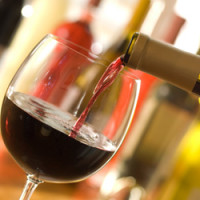The Garagiste Festival: Southern Exposure 2014, held March 29 and 30 in the historic and beautiful Veterans’ Memorial Hall in Solvang, Calif.
I poured at the Saturday morning seminar, “Rhones Rule: The Wines of Ballard Canyon,” which featured three vintners: Michael Larner of Larner Vineyards, Larry Schaffer of Tercero Wines, and Mikael Sigouin of Kaena Wine Company. Each vintner brought along two wines, either Grenache or Syrah.
These three vintners either grow or buy grapes in one of California’s newly minted AVAs (American Viticulture Region), Ballard Canyon in the Santa Ynez Valley. The Federal Alcohol and Tobacco Tax and Trade Bureau (TTB) recognized this new AVA on October 1, 2013, and Ballard Canyon joined Santa Rita Hills AVA and Happy Canyon AVA as the three distinguished growing areas of Santa Barbara County. Comprising 7,800 acres, it’s located in a canyon located between the towns of Solvang, Buellton, and Los Olivos.
What significance is this to wine consumers?
First of all, we will now begin seeing wine labels from Larner, Tercero and Kaena, as well as close to a couple dozen other wineries, carry the term “Ballard Canyon,” whereas before they might say “Santa Ynez Valley” or simply “Larner Vineyard.”
But even more importantly, the AVA designation signifies that the grapes used in these wines have a proven track record for producing high-quality, world-class wines particularly in the northern Rhone style. 
And while there may be similarities in Ballard Canyon AVA wines, there will be significant differences too. There may be more minerality or earthiness to the grapes, depending on which vineyard within the AVA they are grown in, or even within the vineyard, as the geological difference of just one row can create two distinctive grapes styles.
In general, the grapes grown in Ballard Canyon AVA are aromatic varietals such as Grenache and Syrah for reds and Viognier, Roussanne and Marsanne for whites. Many other varietals are grown in Ballard Canyon too, including Sangiovese, Cabernet Sauvignon (reds), Sauvignon Blanc, and Grenache Blanc (whites).
Now, back to the seminar. How did the Ballard Canyon AVA wines taste? Were they distinctly different or similar? Yes and yes.
The two Kaena Grenaches were from two different Ballard Canyon vineyards. Both were lovely, but the 2011from the Tierra Alta Vineyard ($38) blew me away with its beautiful fruit – raspberries mostly – its lightness, and its refreshingly long finish. It’s a very feminine wine, in my opinion. I would describe the 2011Kaena Grenache from the Larner Vineyard ($44) as more masculine, with pronounced minerality, richer tannins, and an earthiness … but lovely too. Mikael Sigouin hails from Oahu and his winery name and labels reflect his background: Kaena, per his Web site (www.kaenawine.com) is a shortened version of his native name and means “potential for greatness.” I would agree with that.
Larry Schaffer of Tercero (www.tercerowines.com) also had a 2009 Grenache ($35), which he sourced from the Larner Vineyard. His tasting notes state he, “Just took what I was ‘given’ and made the best wine possible.” And that he did. Also lovely, this version was different from Kaena’s, even though they were sourced from the same vineyard – Tercero’s being less fruit forward, and more earthy and full-bodied.
All three Syrahs were also similar yet distinct.
Tercero’s 2009 Syrah, sourced from Larner Vineyards, was blended with 5% Viognier, which brings a smoothness to this bold, black fruity, spicy wine. It’s drinkable now, but also suitable for aging five years or more.
Michael Larner, a second-generation vintner, is from the family that owns Larner Vineyards. His label is Larner Wines (www.larnerwines.com). At the seminar he showcased his 2009 ($38) and 2010 ($38) Estate Syrahs. Both displayed the bold black fruit richness of Syrah, with spices and espresso notes. The difference was in the barrels, with the 2009 using some American oak and the 2010 using all French oak – nuances that affect the outcome.
The takeaway from this seminar, besides the fact that all three vintners are passionate, articulate and instrumental in the development of the Ballard Canyon AVA, is that the same grape from the same AVA may find different expressions depending on the exact location within the AVA as well as the wine maker. And, Ballard Canyon AVA is one to watch. All of the wines poured at this seminar were small lots, ranging from just 100 to 30 cases total, so I suggest you hunt them down now before they sell out.
All the wines can be purchased directly from the vineyards or from The Wandering Dog (http://wanderingdogwinebar.com) wine club in Solvang.
Until next time, Cheers!
A special thank you to the producers of The Garagiste Festival: Southern Exposure – Stewart McLennan, Doug Minnick, Lisa Dinsmore, and Melanie Webber. I will pour for you any time! For more information visit http://californiagaragistes.com/.
Theresa Nozick





 Hi I’m Catherine, founder of Wine Women And Chocolate. Want to become a contributor for Wine, Women & Chocolate? Interested in sharing your unique perspective to a group of supportive, like-minded women?
Hi I’m Catherine, founder of Wine Women And Chocolate. Want to become a contributor for Wine, Women & Chocolate? Interested in sharing your unique perspective to a group of supportive, like-minded women?